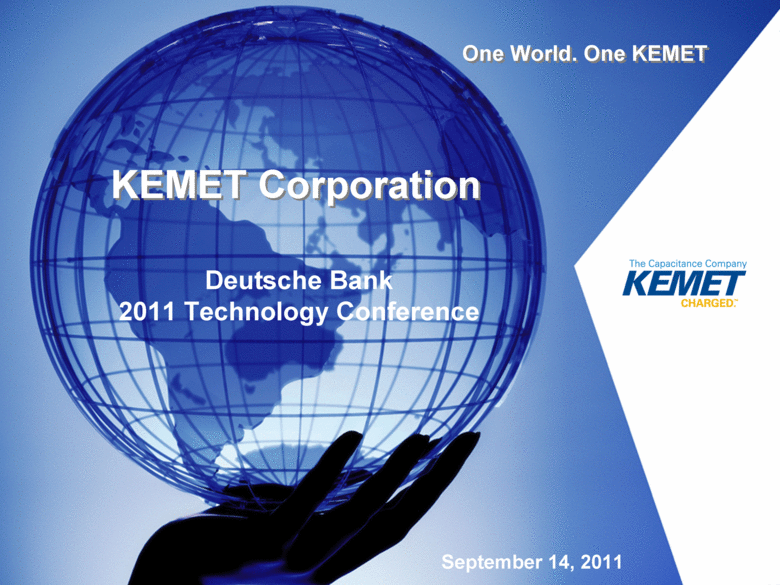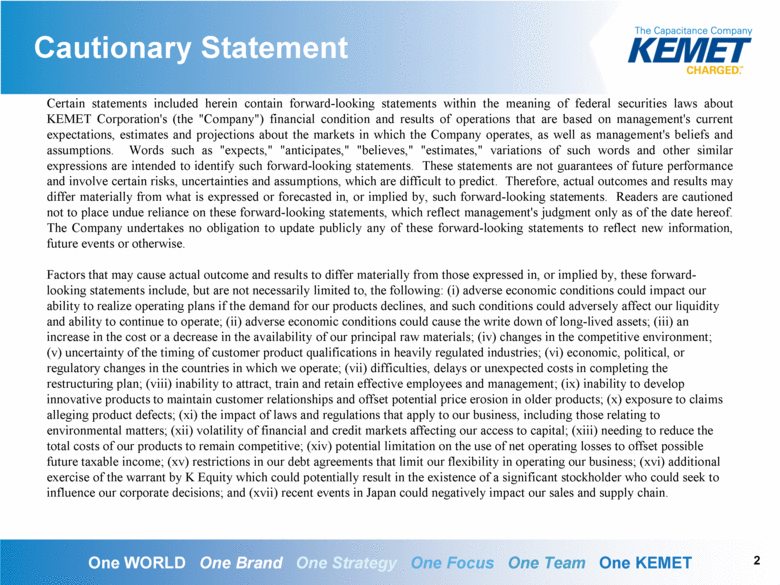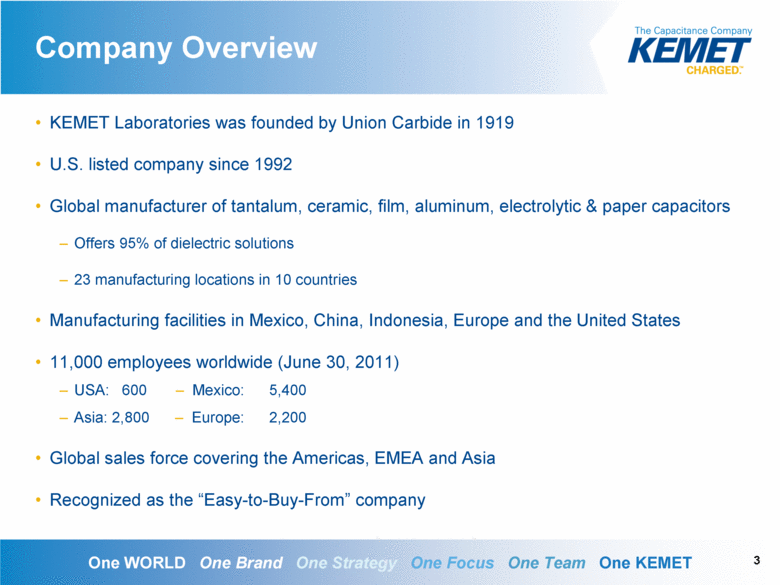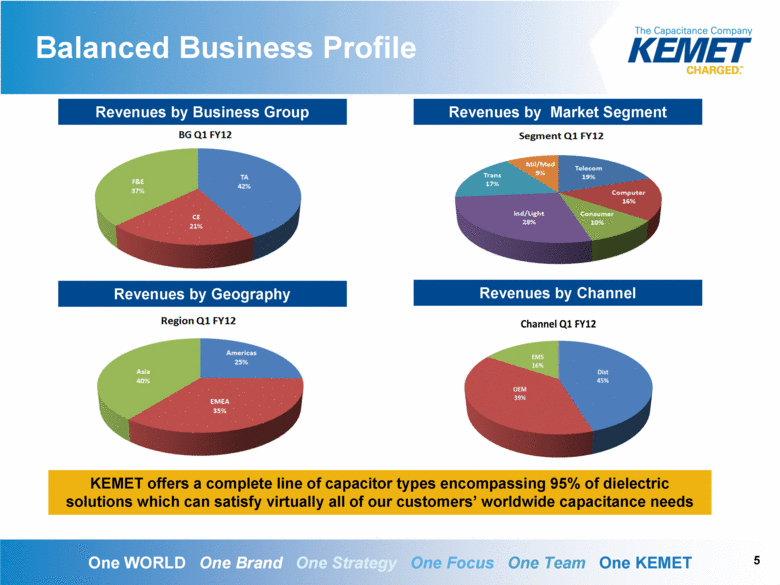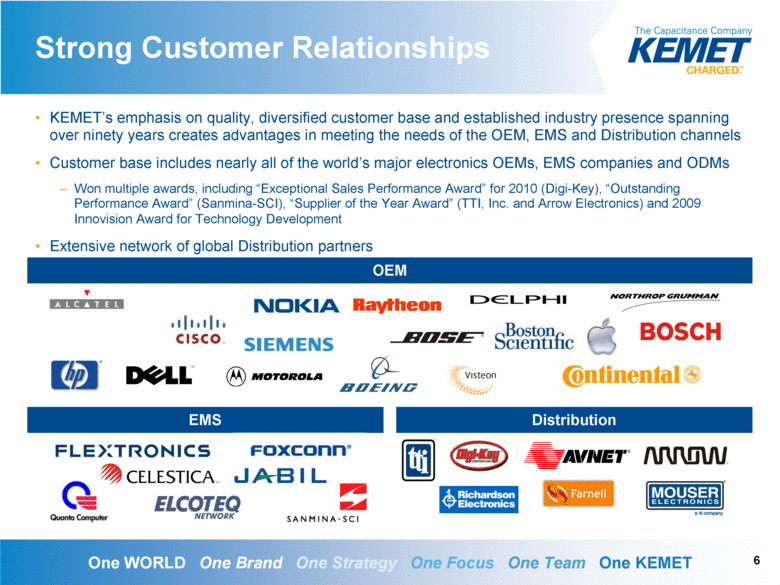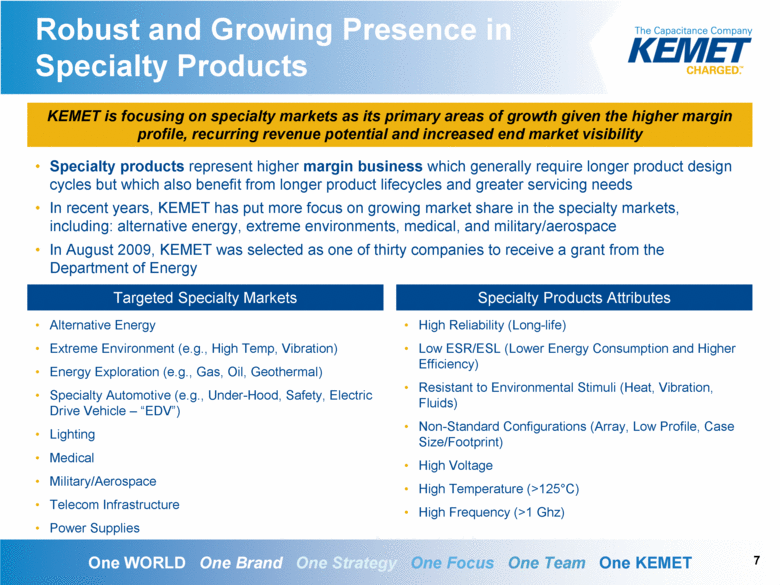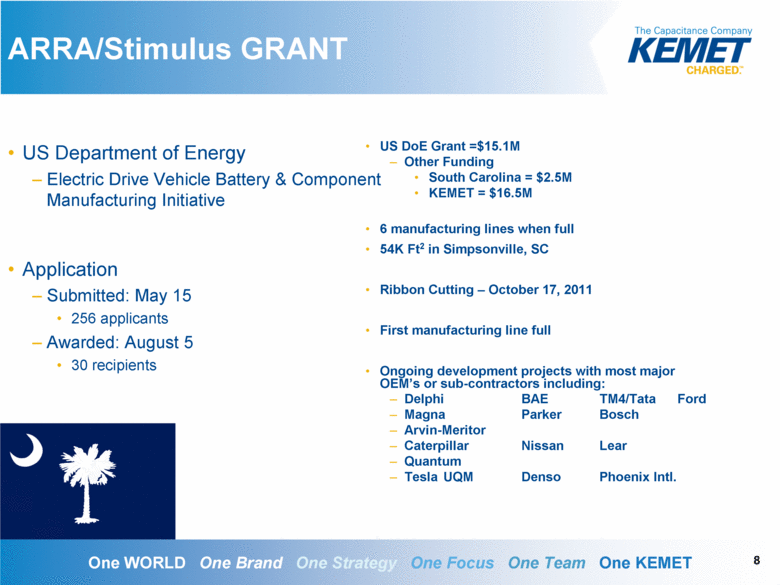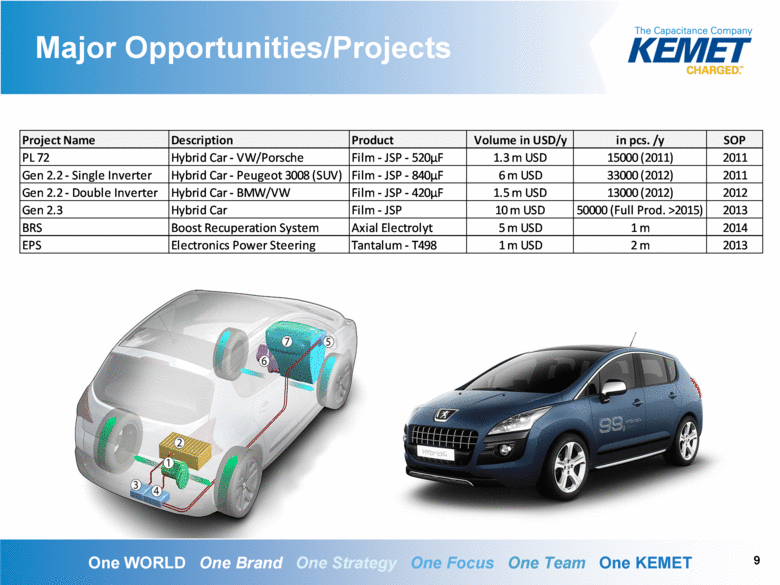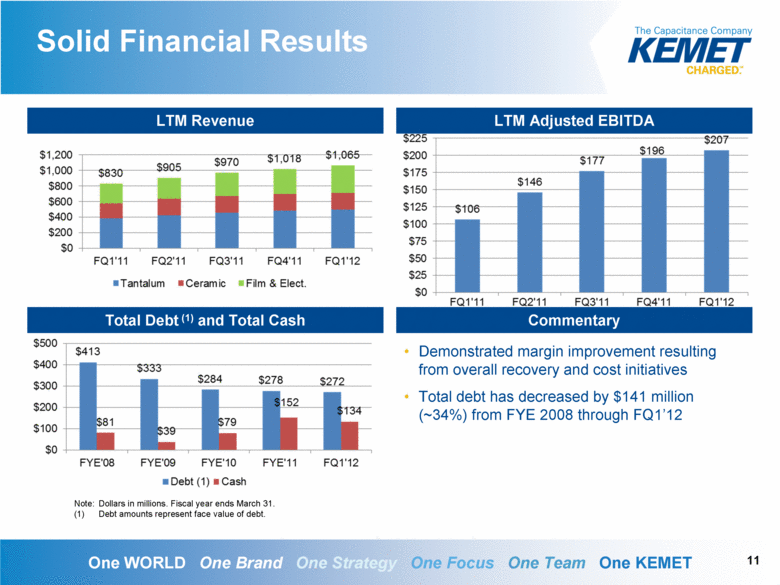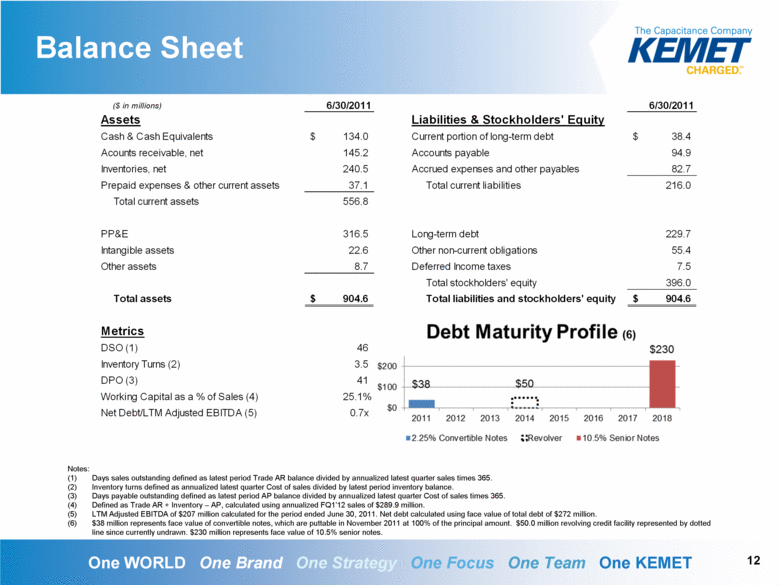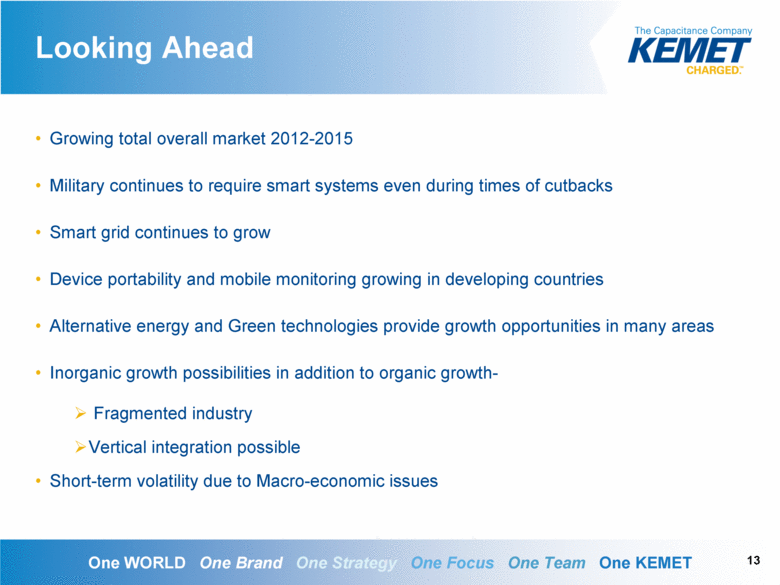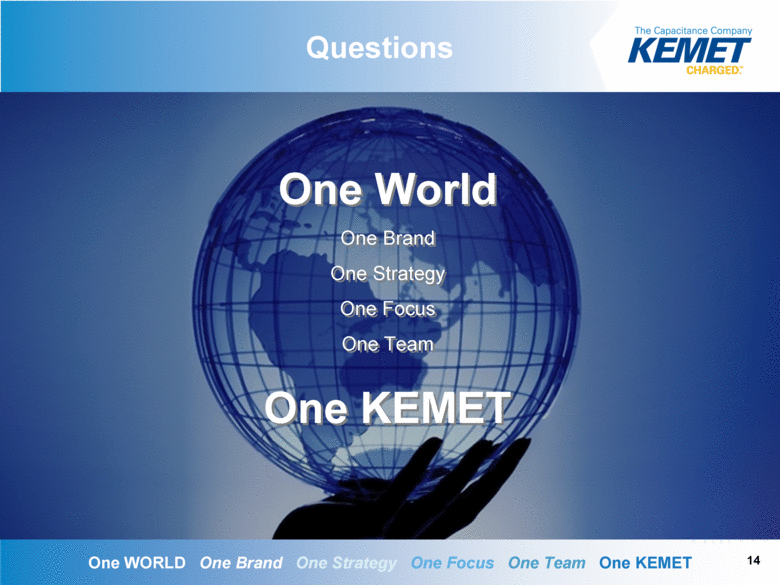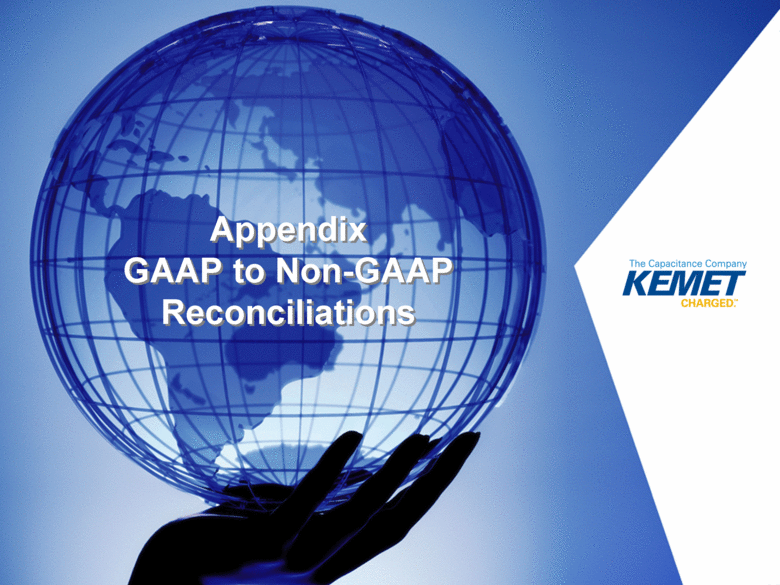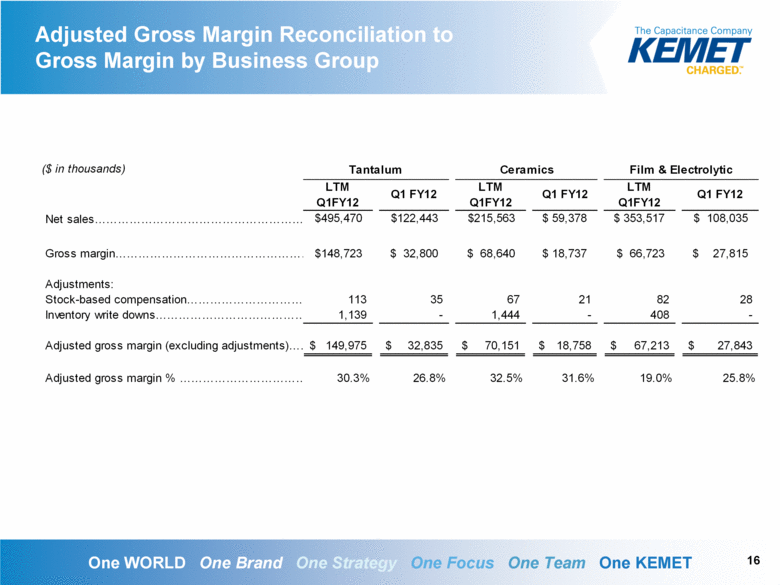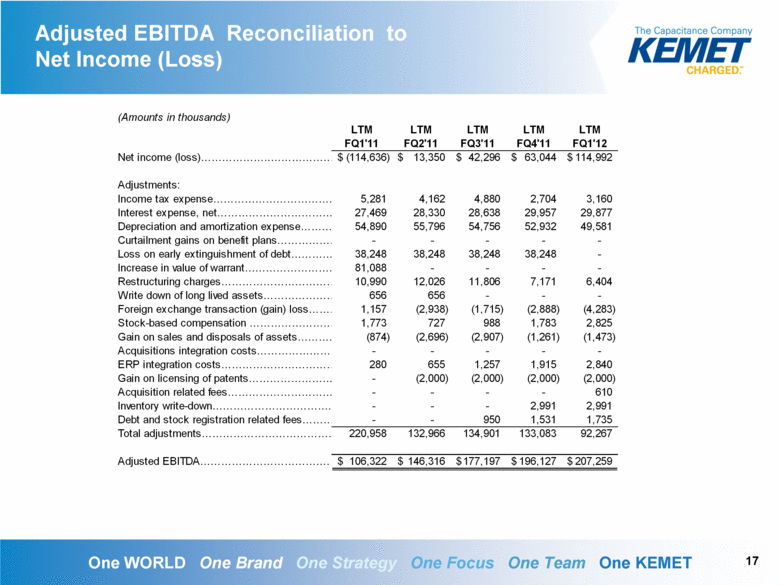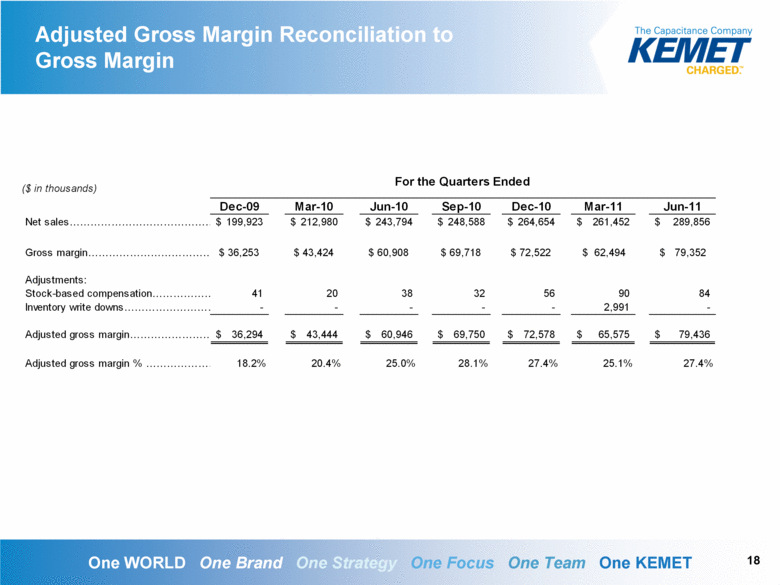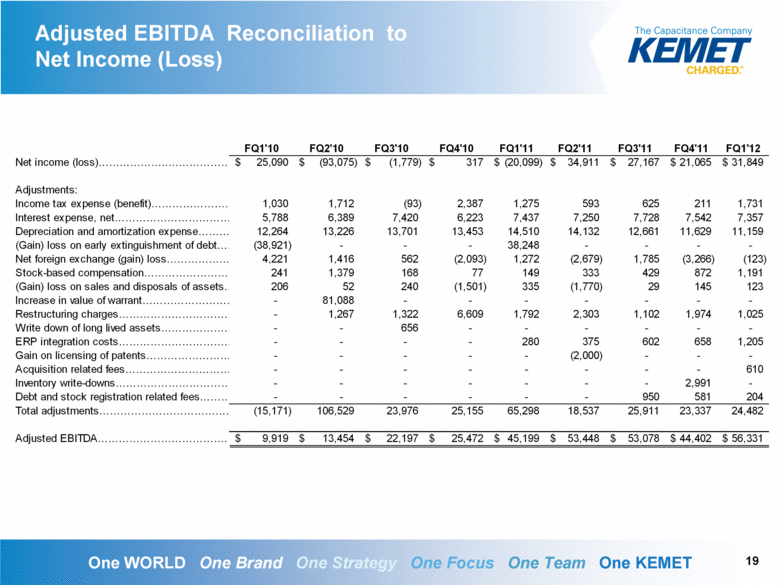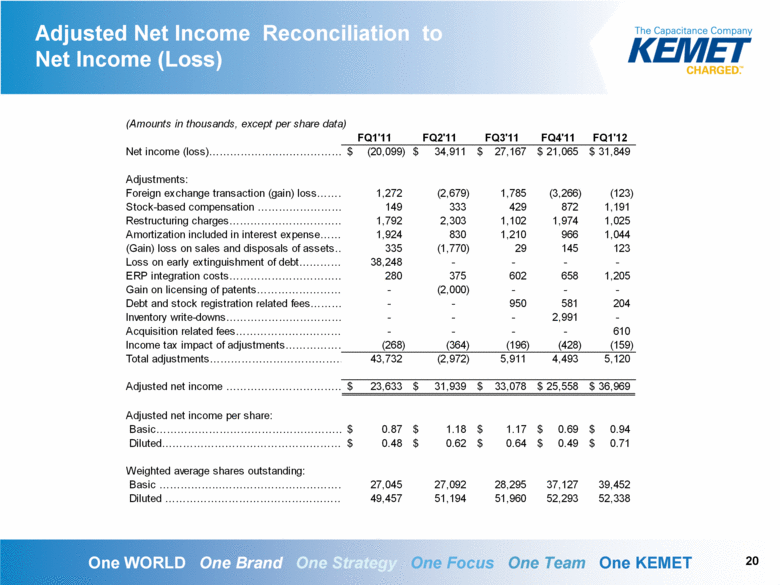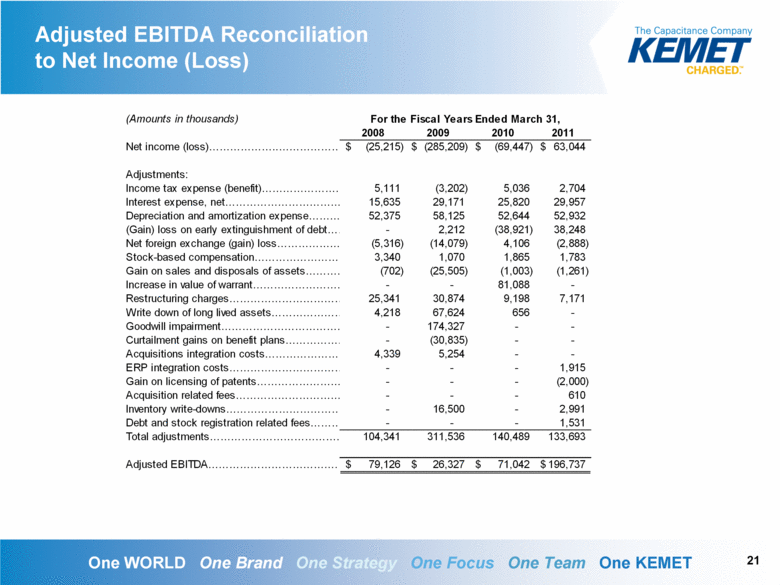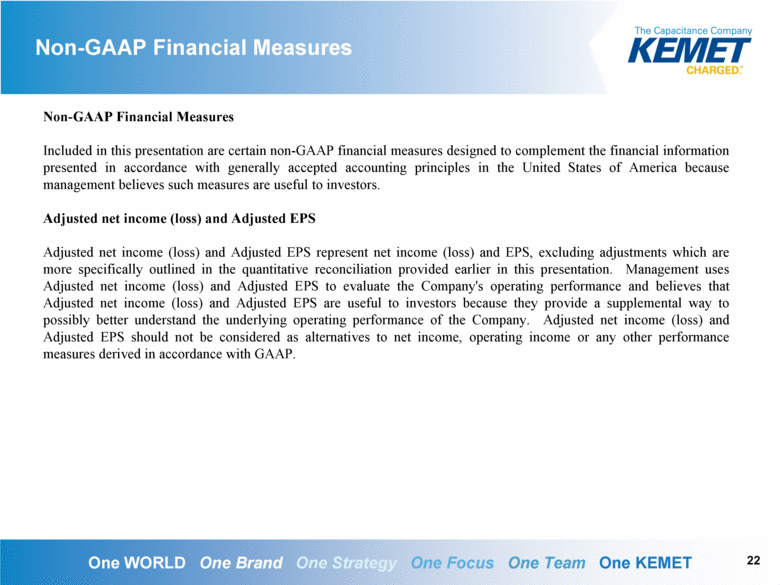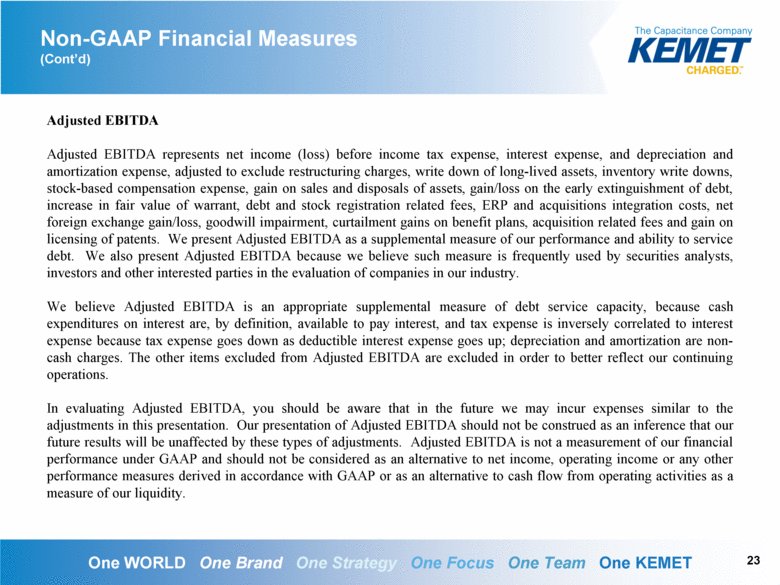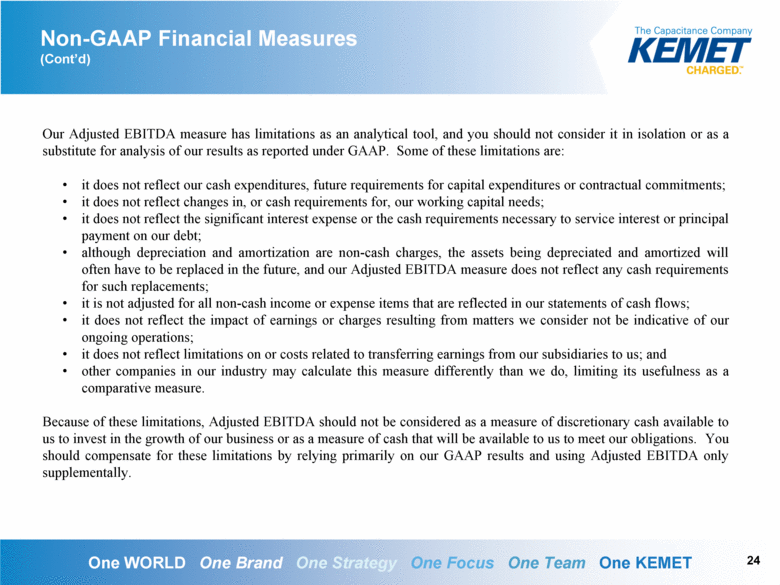Attached files
| file | filename |
|---|---|
| 8-K - 8-K - KEMET CORP | a11-26341_18k.htm |
Exhibit 99.1
|
|
One World. One KEMET KEMET Corporation Deutsche Bank 2011 Technology Conference September 14, 2011 |
|
|
Cautionary Statement 2 Certain statements included herein contain forward-looking statements within the meaning of federal securities laws about KEMET Corporation's (the "Company") financial condition and results of operations that are based on management's current expectations, estimates and projections about the markets in which the Company operates, as well as management's beliefs and assumptions. Words such as "expects," "anticipates," "believes," "estimates," variations of such words and other similar expressions are intended to identify such forward-looking statements. These statements are not guarantees of future performance and involve certain risks, uncertainties and assumptions, which are difficult to predict. Therefore, actual outcomes and results may differ materially from what is expressed or forecasted in, or implied by, such forward-looking statements. Readers are cautioned not to place undue reliance on these forward-looking statements, which reflect management's judgment only as of the date hereof. The Company undertakes no obligation to update publicly any of these forward-looking statements to reflect new information, future events or otherwise. Factors that may cause actual outcome and results to differ materially from those expressed in, or implied by, these forward-looking statements include, but are not necessarily limited to, the following: (i) adverse economic conditions could impact our ability to realize operating plans if the demand for our products declines, and such conditions could adversely affect our liquidity and ability to continue to operate; (ii) adverse economic conditions could cause the write down of long-lived assets; (iii) an increase in the cost or a decrease in the availability of our principal raw materials; (iv) changes in the competitive environment; (v) uncertainty of the timing of customer product qualifications in heavily regulated industries; (vi) economic, political, or regulatory changes in the countries in which we operate; (vii) difficulties, delays or unexpected costs in completing the restructuring plan; (viii) inability to attract, train and retain effective employees and management; (ix) inability to develop innovative products to maintain customer relationships and offset potential price erosion in older products; (x) exposure to claims alleging product defects; (xi) the impact of laws and regulations that apply to our business, including those relating to environmental matters; (xii) volatility of financial and credit markets affecting our access to capital; (xiii) needing to reduce the total costs of our products to remain competitive; (xiv) potential limitation on the use of net operating losses to offset possible future taxable income; (xv) restrictions in our debt agreements that limit our flexibility in operating our business; (xvi) additional exercise of the warrant by K Equity which could potentially result in the existence of a significant stockholder who could seek to influence our corporate decisions; and (xvii) recent events in Japan could negatively impact our sales and supply chain. |
|
|
3 Company Overview KEMET Laboratories was founded by Union Carbide in 1919 U.S. listed company since 1992 Global manufacturer of tantalum, ceramic, film, aluminum, electrolytic & paper capacitors Offers 95% of dielectric solutions 23 manufacturing locations in 10 countries Manufacturing facilities in Mexico, China, Indonesia, Europe and the United States 11,000 employees worldwide (June 30, 2011) USA: 600 – Mexico: 5,400 Asia: 2,800 – Europe: 2,200 Global sales force covering the Americas, EMEA and Asia Recognized as the “Easy-to-Buy-From” company |
|
|
Market Overview |
|
|
Balanced Business Profile 5 Revenues by Market Segment Revenues by Business Group Revenues by Channel Revenues by Geography KEMET offers a complete line of capacitor types encompassing 95% of dielectric solutions which can satisfy virtually all of our customers’ worldwide capacitance needs |
|
|
6 Strong Customer Relationships KEMET’s emphasis on quality, diversified customer base and established industry presence spanning over ninety years creates advantages in meeting the needs of the OEM, EMS and Distribution channels Customer base includes nearly all of the world’s major electronics OEMs, EMS companies and ODMs Won multiple awards, including “Exceptional Sales Performance Award” for 2010 (Digi-Key), “Outstanding Performance Award” (Sanmina-SCI), “Supplier of the Year Award” (TTI, Inc. and Arrow Electronics) and 2009 Innovision Award for Technology Development Extensive network of global Distribution partners Distribution EMS OEM |
|
|
7 Robust and Growing Presence in Specialty Products Specialty products represent higher margin business which generally require longer product design cycles but which also benefit from longer product lifecycles and greater servicing needs In recent years, KEMET has put more focus on growing market share in the specialty markets, including: alternative energy, extreme environments, medical, and military/aerospace In August 2009, KEMET was selected as one of thirty companies to receive a grant from the Department of Energy Alternative Energy Extreme Environment (e.g., High Temp, Vibration) Energy Exploration (e.g., Gas, Oil, Geothermal) Specialty Automotive (e.g., Under-Hood, Safety, Electric Drive Vehicle – “EDV”) Lighting Medical Military/Aerospace Telecom Infrastructure Power Supplies High Reliability (Long-life) Low ESR/ESL (Lower Energy Consumption and Higher Efficiency) Resistant to Environmental Stimuli (Heat, Vibration, Fluids) Non-Standard Configurations (Array, Low Profile, Case Size/Footprint) High Voltage High Temperature (>125°C) High Frequency (>1 Ghz) Specialty Products Attributes Targeted Specialty Markets KEMET is focusing on specialty markets as its primary areas of growth given the higher margin profile, recurring revenue potential and increased end market visibility |
|
|
US Department of Energy Electric Drive Vehicle Battery & Component Manufacturing Initiative Application Submitted: May 15 256 applicants Awarded: August 5 30 recipients US DoE Grant =$15.1M Other Funding South Carolina = $2.5M KEMET = $16.5M 6 manufacturing lines when full 54K Ft2 in Simpsonville, SC Ribbon Cutting – October 17, 2011 First manufacturing line full Ongoing development projects with most major OEM’s or sub-contractors including: Delphi BAE TM4/Tata Ford Magna Parker Bosch Arvin-Meritor Caterpillar Nissan Lear Quantum Tesla UQM Denso Phoenix Intl. ARRA/Stimulus GRANT 8 |
|
|
Major Opportunities/Projects 9 Project Name Description Product Volume in USD/y in pcs. /y SOP PL 72 Hybrid Car - VW/Porsche Film - JSP - 520µF 1.3 m USD 15000 (2011) 2011 Gen 2.2 - Single Inverter Hybrid Car - Peugeot 3008 (SUV) Film - JSP - 840µF 6 m USD 33000 (2012) 2011 Gen 2.2 - Double Inverter Hybrid Car - BMW/VW Film - JSP - 420µF 1.5 m USD 13000 (2012) 2012 Gen 2.3 Hybrid Car Film - JSP 10 m USD 50000 (Full Prod. >2015) 2013 BRS Boost Recuperation System Axial Electrolyt 5 m USD 1 m 2014 EPS Electronics Power Steering Tantalum - T498 1 m USD 2 m 2013 |
|
|
Financial Overview |
|
|
11 Solid Financial Results Commentary Total Debt (1) and Total Cash LTM Adjusted EBITDA LTM Revenue Note: Dollars in millions. Fiscal year ends March 31. (1) Debt amounts represent face value of debt. Demonstrated margin improvement resulting from overall recovery and cost initiatives Total debt has decreased by $141 million (~34%) from FYE 2008 through FQ1’12 |
|
|
Balance Sheet 12 Notes: Days sales outstanding defined as latest period Trade AR balance divided by annualized latest quarter sales times 365. Inventory turns defined as annualized latest quarter Cost of sales divided by latest period inventory balance. Days payable outstanding defined as latest period AP balance divided by annualized latest quarter Cost of sales times 365. Defined as Trade AR + Inventory – AP, calculated using annualized FQ1’12 sales of $289.9 million. LTM Adjusted EBITDA of $207 million calculated for the period ended June 30, 2011. Net debt calculated using face value of total debt of $272 million. $38 million represents face value of convertible notes, which are puttable in November 2011 at 100% of the principal amount. $50.0 million revolving credit facility represented by dotted line since currently undrawn. $230 million represents face value of 10.5% senior notes. ($ in millions) 6/30/2011 6/30/2011 Assets Liabilities & Stockholders' Equity Cash & Cash Equivalents 134.0 $ Current portion of long-term debt 38.4 $ Acounts receivable, net 145.2 Accounts payable 94.9 Inventories, net 240.5 Accrued expenses and other payables 82.7 Prepaid expenses & other current assets 37.1 Total current liabilities 216.0 Total current assets 556.8 PP&E 316.5 Long-term debt 229.7 Intangible assets 22.6 Other non-current obligations 55.4 Other assets 8.7 Deferred Income taxes 7.5 Total stockholders' equity 396.0 Total assets 904.6 $ Total liabilities and stockholders' equity 904.6 $ Metrics DSO (1) 46 Inventory Turns (2) 3.5 DPO (3) 41 Working Capital as a % of Sales (4) 25.1% Net Debt/LTM Adjusted EBITDA (5) 0.7x |
|
|
Looking Ahead 13 Growing total overall market 2012-2015 Military continues to require smart systems even during times of cutbacks Smart grid continues to grow Device portability and mobile monitoring growing in developing countries Alternative energy and Green technologies provide growth opportunities in many areas Inorganic growth possibilities in addition to organic growth- Fragmented industry Vertical integration possible Short-term volatility due to Macro-economic issues |
|
|
Questions One World One Brand One Strategy One Focus One Team One KEMET 14 |
|
|
Appendix GAAP to Non-GAAP Reconciliations |
|
|
16 Adjusted Gross Margin Reconciliation to Gross Margin by Business Group ($ in thousands) LTM Q1FY12 Q1 FY12 LTM Q1FY12 Q1 FY12 LTM Q1FY12 Q1 FY12 Net sales $495,470 $122,443 $215,563 $ 59,378 $ 353,517 $ 108,035 Gross margin $148,723 $ 32,800 $ 68,640 $ 18,737 $ 66,723 $ 27,815 Adjustments: Stock-based compensation. 113 35 67 21 82 28 Inventory write downs 1,139 - 1,444 - 408 - Adjusted gross margin (excluding adjustments). 149,975 $ 32,835 $ 70,151 $ 18,758 $ 67,213 $ 27,843 $ Adjusted gross margin % 30.3% 26.8% 32.5% 31.6% 19.0% 25.8% Tantalum Ceramics Film & Electrolytic |
|
|
Adjusted EBITDA Reconciliation to Net Income (Loss) 17 (Amounts in thousands) LTM FQ1'11 LTM FQ2'11 LTM FQ3'11 LTM FQ4'11 LTM FQ1'12 Net income (loss) (114,636) $ 13,350 $ 42,296 $ 63,044 $ 114,992 $ Adjustments: Income tax expense. 5,281 4,162 4,880 2,704 3,160 Interest expense, net. 27,469 28,330 28,638 29,957 29,877 Depreciation and amortization expense. 54,890 55,796 54,756 52,932 49,581 Curtailment gains on benefit plans - - - - - Loss on early extinguishment of debt. 38,248 38,248 38,248 38,248 - Increase in value of warrant. 81,088 - - - - Restructuring charges. 10,990 12,026 11,806 7,171 6,404 Write down of long lived assets. 656 656 - - - Foreign exchange transaction (gain) loss. 1,157 (2,938) (1,715) (2,888) (4,283) Stock-based compensation 1,773 727 988 1,783 2,825 Gain on sales and disposals of assets. (874) (2,696) (2,907) (1,261) (1,473) Acquisitions integration costs - - - - - ERP integration costs 280 655 1,257 1,915 2,840 Gain on licensing of patents. - (2,000) (2,000) (2,000) (2,000) Acquisition related fees. - - - - 610 Inventory write-down - - - 2,991 2,991 Debt and stock registration related fees. - - 950 1,531 1,735 Total adjustments 220,958 132,966 134,901 133,083 92,267 Adjusted EBITDA. 106,322 $ 146,316 $ 177,197 $ 196,127 $ 207,259 $ |
|
|
18 Adjusted Gross Margin Reconciliation to Gross Margin ($ in thousands) Dec-09 Mar-10 Jun-10 Sep-10 Dec-10 Mar-11 Jun-11 Net sales 199,923 $ 212,980 $ 243,794 $ 248,588 $ 264,654 $ 261,452 $ 289,856 $ Gross margin $ 36,253 $ 43,424 $ 60,908 $ 69,718 $ 72,522 $ 62,494 $ 79,352 Adjustments: Stock-based compensation. 41 20 38 32 56 90 84 Inventory write downs - - - - - 2,991 - Adjusted gross margin 36,294 $ 43,444 $ 60,946 $ 69,750 $ 72,578 $ 65,575 $ 79,436 $ Adjusted gross margin % 18.2% 20.4% 25.0% 28.1% 27.4% 25.1% 27.4% For the Quarters Ended |
|
|
Adjusted EBITDA Reconciliation to Net Income (Loss) 19 FQ1'10 FQ2'10 FQ3'10 FQ4'10 FQ1'11 FQ2'11 FQ3'11 FQ4'11 FQ1'12 Net income (loss) 25,090 $ (93,075) $ (1,779) $ 317 $ (20,099) $ 34,911 $ 27,167 $ 21,065 $ 31,849 $ Adjustments: Income tax expense (benefit). 1,030 1,712 (93) 2,387 1,275 593 625 211 1,731 Interest expense, net. 5,788 6,389 7,420 6,223 7,437 7,250 7,728 7,542 7,357 Depreciation and amortization expense. 12,264 13,226 13,701 13,453 14,510 14,132 12,661 11,629 11,159 (Gain) loss on early extinguishment of debt. (38,921) - - - 38,248 - - - - Net foreign exchange (gain) loss. 4,221 1,416 562 (2,093) 1,272 (2,679) 1,785 (3,266) (123) Stock-based compensation 241 1,379 168 77 149 333 429 872 1,191 (Gain) loss on sales and disposals of assets. 206 52 240 (1,501) 335 (1,770) 29 145 123 Increase in value of warrant. - 81,088 - - - - - - - Restructuring charges. - 1,267 1,322 6,609 1,792 2,303 1,102 1,974 1,025 Write down of long lived assets. - - 656 - - - - - - ERP integration costs - - - - 280 375 602 658 1,205 Gain on licensing of patents. - - - - - (2,000) - - - Acquisition related fees - - - - - - - - 610 Inventory write-downs. - - - - - - - 2,991 - Debt and stock registration related fees - - - - - - 950 581 204 Total adjustments (15,171) 106,529 23,976 25,155 65,298 18,537 25,911 23,337 24,482 Adjusted EBITDA. 9,919 $ 13,454 $ 22,197 $ 25,472 $ 45,199 $ 53,448 $ 53,078 $ 44,402 $ 56,331 $ |
|
|
Adjusted Net Income Reconciliation to Net Income (Loss) 20 (Amounts in thousands, except per share data) FQ1'11 FQ2'11 FQ3'11 FQ4'11 FQ1'12 Net income (loss) (20,099) $ 34,911 $ 27,167 $ 21,065 $ 31,849 $ Adjustments: Foreign exchange transaction (gain) loss. 1,272 (2,679) 1,785 (3,266) (123) Stock-based compensation 149 333 429 872 1,191 Restructuring charges 1,792 2,303 1,102 1,974 1,025 Amortization included in interest expense. 1,924 830 1,210 966 1,044 (Gain) loss on sales and disposals of assets 335 (1,770) 29 145 123 Loss on early extinguishment of debt. 38,248 - - - - ERP integration costs 280 375 602 658 1,205 Gain on licensing of patents. - (2,000) - - - Debt and stock registration related fees - - 950 581 204 Inventory write-downs - - - 2,991 - Acquisition related fees - - - - 610 Income tax impact of adjustments. (268) (364) (196) (428) (159) Total adjustments 43,732 (2,972) 5,911 4,493 5,120 Adjusted net income 23,633 $ 31,939 $ 33,078 $ 25,558 $ 36,969 $ Adjusted net income per share: Basic 0.87 $ 1.18 $ 1.17 $ 0.69 $ 0.94 $ Diluted 0.48 $ 0.62 $ 0.64 $ 0.49 $ 0.71 $ Weighted average shares outstanding: Basic 27,045 27,092 28,295 37,127 39,452 Diluted 49,457 51,194 51,960 52,293 52,338 |
|
|
21 Adjusted EBITDA Reconciliation to Net Income (Loss) (Amounts in thousands) 2008 2009 2010 2011 Net income (loss) (25,215) $ (285,209) $ (69,447) $ 63,044 $ Adjustments: Income tax expense (benefit). 5,111 (3,202) 5,036 2,704 Interest expense, net. 15,635 29,171 25,820 29,957 Depreciation and amortization expense. 52,375 58,125 52,644 52,932 (Gain) loss on early extinguishment of debt. - 2,212 (38,921) 38,248 Net foreign exchange (gain) loss. (5,316) (14,079) 4,106 (2,888) Stock-based compensation 3,340 1,070 1,865 1,783 Gain on sales and disposals of assets. (702) (25,505) (1,003) (1,261) Increase in value of warrant. - - 81,088 - Restructuring charges. 25,341 30,874 9,198 7,171 Write down of long lived assets. 4,218 67,624 656 - Goodwill impairment - 174,327 - - Curtailment gains on benefit plans. - (30,835) - - Acquisitions integration costs 4,339 5,254 - - ERP integration costs - - - 1,915 Gain on licensing of patents. - - - (2,000) Acquisition related fees - - - 610 Inventory write-downs. - 16,500 - 2,991 Debt and stock registration related fees - - - 1,531 Total adjustments 104,341 311,536 140,489 133,693 Adjusted EBITDA. 79,126 $ 26,327 $ 71,042 $ 196,737 $ For the Fiscal Years Ended March 31, |
|
|
Non-GAAP Financial Measures Non-GAAP Financial Measures Included in this presentation are certain non-GAAP financial measures designed to complement the financial information presented in accordance with generally accepted accounting principles in the United States of America because management believes such measures are useful to investors. Adjusted net income (loss) and Adjusted EPS Adjusted net income (loss) and Adjusted EPS represent net income (loss) and EPS, excluding adjustments which are more specifically outlined in the quantitative reconciliation provided earlier in this presentation. Management uses Adjusted net income (loss) and Adjusted EPS to evaluate the Company's operating performance and believes that Adjusted net income (loss) and Adjusted EPS are useful to investors because they provide a supplemental way to possibly better understand the underlying operating performance of the Company. Adjusted net income (loss) and Adjusted EPS should not be considered as alternatives to net income, operating income or any other performance measures derived in accordance with GAAP. 22 |
|
|
Non-GAAP Financial Measures (Cont’d) Adjusted EBITDA Adjusted EBITDA represents net income (loss) before income tax expense, interest expense, and depreciation and amortization expense, adjusted to exclude restructuring charges, write down of long-lived assets, inventory write downs, stock-based compensation expense, gain on sales and disposals of assets, gain/loss on the early extinguishment of debt, increase in fair value of warrant, debt and stock registration related fees, ERP and acquisitions integration costs, net foreign exchange gain/loss, goodwill impairment, curtailment gains on benefit plans, acquisition related fees and gain on licensing of patents. We present Adjusted EBITDA as a supplemental measure of our performance and ability to service debt. We also present Adjusted EBITDA because we believe such measure is frequently used by securities analysts, investors and other interested parties in the evaluation of companies in our industry. We believe Adjusted EBITDA is an appropriate supplemental measure of debt service capacity, because cash expenditures on interest are, by definition, available to pay interest, and tax expense is inversely correlated to interest expense because tax expense goes down as deductible interest expense goes up; depreciation and amortization are non-cash charges. The other items excluded from Adjusted EBITDA are excluded in order to better reflect our continuing operations. In evaluating Adjusted EBITDA, you should be aware that in the future we may incur expenses similar to the adjustments in this presentation. Our presentation of Adjusted EBITDA should not be construed as an inference that our future results will be unaffected by these types of adjustments. Adjusted EBITDA is not a measurement of our financial performance under GAAP and should not be considered as an alternative to net income, operating income or any other performance measures derived in accordance with GAAP or as an alternative to cash flow from operating activities as a measure of our liquidity. 23 |
|
|
Non-GAAP Financial Measures (Cont’d) Our Adjusted EBITDA measure has limitations as an analytical tool, and you should not consider it in isolation or as a substitute for analysis of our results as reported under GAAP. Some of these limitations are: it does not reflect our cash expenditures, future requirements for capital expenditures or contractual commitments; it does not reflect changes in, or cash requirements for, our working capital needs; it does not reflect the significant interest expense or the cash requirements necessary to service interest or principal payment on our debt; although depreciation and amortization are non-cash charges, the assets being depreciated and amortized will often have to be replaced in the future, and our Adjusted EBITDA measure does not reflect any cash requirements for such replacements; it is not adjusted for all non-cash income or expense items that are reflected in our statements of cash flows; it does not reflect the impact of earnings or charges resulting from matters we consider not be indicative of our ongoing operations; it does not reflect limitations on or costs related to transferring earnings from our subsidiaries to us; and other companies in our industry may calculate this measure differently than we do, limiting its usefulness as a comparative measure. Because of these limitations, Adjusted EBITDA should not be considered as a measure of discretionary cash available to us to invest in the growth of our business or as a measure of cash that will be available to us to meet our obligations. You should compensate for these limitations by relying primarily on our GAAP results and using Adjusted EBITDA only supplementally. 24 |

